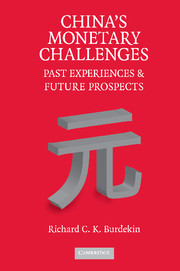Book contents
- Frontmatter
- Contents
- Preface
- Introduction: China Today and Lessons from the Past
- PART I CHINA'S EXCHANGE RATE REGIME AND MONETARY POLICY
- PART II THE IMPORTANCE OF INTERNATIONAL FACTORS, PAST AND PRESENT
- 5 US Pressure on China and Hong Kong in the 1930s
- 6 Inflation Transmission to Taiwan in the 1940s
- 7 WTO Challenges and China's Banking Sector Today
- PART III THE PEOPLE'S REPUBLIC'S ROLE WITHIN GREATER CHINA AND ASIA
- 10 Conclusions and Future Prospects for the Renminbi
- References
- Author Index
- Subject Index
6 - Inflation Transmission to Taiwan in the 1940s
Published online by Cambridge University Press: 06 July 2010
- Frontmatter
- Contents
- Preface
- Introduction: China Today and Lessons from the Past
- PART I CHINA'S EXCHANGE RATE REGIME AND MONETARY POLICY
- PART II THE IMPORTANCE OF INTERNATIONAL FACTORS, PAST AND PRESENT
- 5 US Pressure on China and Hong Kong in the 1930s
- 6 Inflation Transmission to Taiwan in the 1940s
- 7 WTO Challenges and China's Banking Sector Today
- PART III THE PEOPLE'S REPUBLIC'S ROLE WITHIN GREATER CHINA AND ASIA
- 10 Conclusions and Future Prospects for the Renminbi
- References
- Author Index
- Subject Index
Summary
As hyperinflation spiraled upward, the Chinese people lost all confidence in the Nationalist government…The issuance of gold yuan notes heralded the last curtain call of the Nationalist government on the mainland of China.
(Ji, 2003, p. 229)Introduction
Whereas the preceding chapter considered the deflationary damage exerted by an artificially overvalued exchange rate in the 1930s, Taiwan's experience at the end of the 1940s offers a vivid illustration of the inflationary pressures that can be generated by an excessively undervalued exchange rate. Resisting upward pressure on the currency in such a case fuels inflation, inter alia, as undervaluation of the domestic currency triggers capital inflows that drive up the money supply. As discussed in Chapter 1, there were fears that central bank loss of control over the money supply in the face of surging capital inflows would lead to this scenario being repeated in mainland China in 2004. “Hot flows” of funds into China appeared to subside in the face of the gradual appreciation effected during 2005–2007, however, and the actual degree of recent renminbi undervaluation remained subject to considerable doubt (Chapter 1). China's accelerating accumulation of foreign exchange reserves has nevertheless required massive sterilization efforts by the People's Bank of China (Chapter 4), and ongoing concerns about imported inflationary pressures prompted a variety of tightening measures, including a succession of reserve requirement increases and interest rate hikes.
- Type
- Chapter
- Information
- China's Monetary ChallengesPast Experiences and Future Prospects, pp. 118 - 135Publisher: Cambridge University PressPrint publication year: 2008



